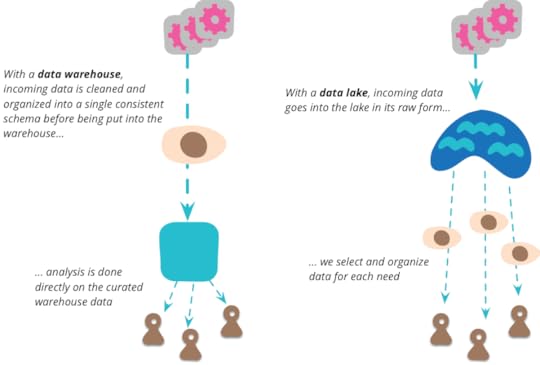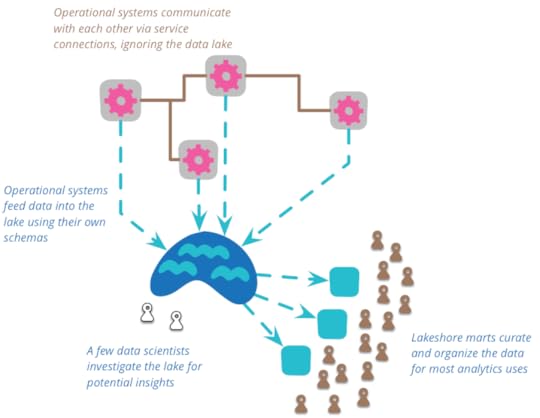Bliki: DataLake
Data Lake is a term that's appeared in this decade to describe
an important component of the data analytics pipeline in the world of
Big Data. The idea is to
have a single store for all of the raw data that anyone in an
organization might need to analyze. Commonly people use
Hadoop to work on the data in the lake, but the concept is broader
than just Hadoop.
When I hear about a single point to pull together all the data
an organization wants to analyze, I immediately think of the notion
of the data warehouse (and data
mart [1]). But there is a vital distinction between the
data lake and the data warehouse. The data lake stores raw
data, in whatever form the data source provides. There is no
assumptions about the schema of the data, each data source can use
whatever schema it likes. It's up to
the consumers of that data to make sense of that data for their own
purposes.

This is an important step, many data warehouse initiatives didn't
get very far because of schema problems. Data warehouses tend to
go with the notion of a single schema for all analytics needs, but
I've taken the view that a single unified data model is impractical
for anything but the smallest organizations. To model even a
slightly complex domain you need multiple
BoundedContexts, each with its own data model. In
analytics terms, you need each analytics user to use a model that
makes sense for the analysis they are doing. By shifting to storing
raw data only, this firmly puts the responsibility on the data
analyst.
Another source of problems for data warehouse initiatives is
ensuring data quality. Trying to get an authoritative single source
for data requires lots of analysis of how the data is acquired and
used by different systems. System A may be good for some data, and
system B for another. You run into rules where system A is better
for more recent orders but system B is better for orders of a month
or more ago, unless returns are involved. On top of this, data
quality is often a subjective issue, different analysis has
different tolerances for data quality issues, or even a different
notion of what is good quality.
This leads to a common criticism of the data lake - that it's just a
dumping ground for data of widely varying quality, better named a
data swamp. The criticism is both valid and irrelevant. The hot
title of the New Analytics is "Data Scientist". Although it's a
much-abused title, many of these folks do have a solid background in
science. And any serious scientist knows all about data quality
problems. Consider what you might think is the simple matter of analyzing temperature readings
over time. You have to take into account that some weather stations
are relocated in ways that may subtly affect the readings, anomalies due to problems
in equipment, missing periods when the sensors aren't working. Many
of the sophisticated statistical techniques out there are created
to sort out data quality problems. Scientists are always skeptical about
data quality and are used to dealing with questionable data. So for
them the lake is important because they get to work with raw data
and can be deliberate about applying techniques to make sense of it,
rather than some opaque data cleansing mechanism that probably does
more harm that good.
Data warehouses usually would not just cleanse but also aggregate
the data into a form that made it easier to analyze. But scientists
tend to object to this too, because aggregation implies throwing
away data. The data lake should contain all the data because you
don't know what people will find valuable, either today or in a
couple of years time.
One of my colleagues illustrated this thinking with a recent
example: "We were trying to
compare our automated predictive models versus manual forecasts made
by the company's contract managers. To do this we decided to train
our models on data only up to about a year ago and compare the
predictions to the ones made by managers at that same time. We now
know the correct results so this should be good test of accuracy.
When we started to do this it appeared that the manager's predictions
were horrible and that even our simple models, made in just two weeks,
were crushing them. We suspected that this was too good (for us) to be
true. After a lot of testing and digging we discovered that the time
stamps associated with those manager predictions were not correct.
They were being modified by some end-of-month processing report. So in
short, these values in the data warehouse were useless and so we
feared that we would have no way of performing this comparison. After
more digging we found that these reports were stored somewhere where we
could get them and extract the real forecasts made at that time.
(We're crushing them again but it's taken many months to get there)."
The complexity of this raw data means that there is room for
something that curates the data into a more manageable structure (as
well as reducing the considerable volume of data.) The data lake shouldn't be
accessed directly very much. Because the data is raw, you need a lot
of skill to make any sense of it. You have relatively few people who
work in the data lake, as they uncover generally useful views of
data in the lake, they can create a number of data marts each of which
has a specific model for a single bounded context. A larger number
of downstream users can then treat these lakeshore marts as an
authoritative source for that context.

So far I've described the data lake as singular point for
integrating data across an enterprise, but I should mention that
isn't how it was originally intended. The term was
coined by James Dixon in 2010, when he did that he intended a
data lake to be used for a single data source, multiple data sources
would instead form a "water garden". Despite its original formulation
the prevalent usage now is to treat a data lake as combining many
sources. [2]
You should use a data lake for analytic purposes, not for
collaboration between operational systems. When operational systems
collaborate they should do this through services designed for the
purpose, such as RESTful HTTP calls, or asynchronous messaging. The
lake is too complex to trawl for operational communication. It may
be that analysis of the lake can lead to new operational
communication routes, but these should be built directly rather than
through the lake.
It is important that all data put in the lake should have a clear
provenance in place and time. Every data item should have a clear
trace to what system it came from and when the data was produced.
The data lake thus contains a historical record. This might come
from feeding Domain Events
into the lake, a natural fit with Event Sourced systems. But it could
also come from systems doing a regular dump of current state into the
lake - an approach that's valuable when the source system doesn't
have any temporal capabilities but you want a temporal
analysis of its data. A consequence of this is that data put into
the lake is immutable, an observation once stated cannot be removed
(although it may be refuted later), you should also expect
ContradictoryObservations.
The data lake is schemaless, it's up to the source systems to
decide what schema to use and for consumers to work out how to deal
with the resulting chaos. Furthermore the source
systems are free to change their inflow data schemas at will, and
again the consumers have to cope. Obviously we prefer such changes
to be as minimally disruptive as possible, but scientists prefer messy
data to losing data.
Data lakes are going to be very large, and much of the storage is
oriented around the notion of a large schemaless structure - which
is why Hadoop and HDFS are usually the technologies people use for
data lakes. One of the vital tasks of the lakeshore marts is to
reduce the amount of data you need to deal with, so that big data analytics
doesn't have to deal with large amounts of data.
The Data Lake's appetite for a deluge of raw data raises awkward
questions about privacy and security. The principle of
Datensparsamkeit is very much in tension with the data
scientists' desire to capture all data now. A data lake makes a
tempting target for crackers, who might love to siphon choice bits
into the public oceans. Restricting direct lake access to a small
data science group may reduce this threat, but doesn't avoid the
question of how that group is kept accountable for the privacy of
the data they sail on.
Notes
1:
The usual distinction is that a data mart is for a single
department in an organization, while a data warehouse integrates
across all departments. Opinions differ on whether a data
warehouse should be the union of all data marts or whether a
data mart is a logical subset (view) of data in the data
warehouse.
2:
In a later blog post, Dixon emphasizes the lake versus water
garden distinction, but (in the comments) says that it is a
minor change. For me the key point is that the lake stores a
large body of data in its natural state, the number of feeder
streams isn't a big deal.
Acknowledgements
My thanks to
Anand Krishnaswamy, Danilo Sato, David Johnston, Derek Hammer, Duncan Cragg, Jonny Leroy, Ken
Collier, Shripad Agashe, and Steven Lowe
for discussing drafts of this post on our internal mailing lists
Martin Fowler's Blog
- Martin Fowler's profile
- 1099 followers






